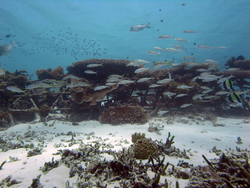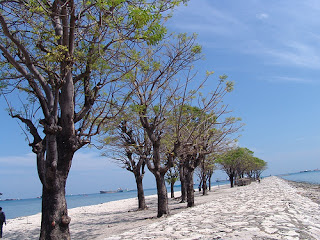Dispatches
Executive summary by darmansjah
Coral reefs are the rain forest of the world’s oceans. Like their terrestrial counterparts, they occur in tropical and subtropical environment, support a bewildering variety of species, and are diminishing at an alarming rate. In fact, some marine scientists are predicting a catastrophic collapse of the planet’s coral ecosystem in the next 50 years. It wouldn’t be the first time-the disappearance of reefs has presaged each of the planet’s five great extinction events on record. If we are indeed entering the sixth, the cause will not be a comet or a big freeze, but for the first time, a living species-human beings.
Against this backdrop, marine biologists the world over are desperately trying to protect our remaining reefs from the impacts of global warming and destructive fishing. Others are building repositories of the known coral species (so that our grandchildren at least get to see them in aquariums or laboratories) and still others are constructing artificial reefs in areas of significant damage. Humans have been creating reefs for thousands of years to improve their fisheries; you can pretty much sink anything solid in the right marine environment and calcium carbonate, the key ingredient in coral, will accrete to it. It’s a hit=-and-miss affair, though, often yielding just a fraction of the biodiversity seen in a natural reef. Nonetheless, in the 1970s some simple science changed the game dramatically.
The Biorock method was developed by architect and marine scientist Wolf Hibertz found that by running a small electrical current through seawater, a hard shell of calcium carbonate would form over time on the cathode, in this case a submerged steel framework. You could then attach small pieces of natural coral to the structure. The corals seemed to love these substrates, achieving growth rates often five times faster than normal, according to Hilbertz and Goreau. Today, there are more than 20 Biorock projects around the globe, but by far the biggest-and arguably the most innovative-are in Indonesia.
“Right now, we have 62 Biorock structures around this island,” says Delphine Robbe. “By 2012, we should have a hundred,” she adds with enough steel in her voice to make me believe her. Since washing up on Gili Trawangan in 2005 with a vague plan to get her dive master certification, the Frenchwoman has become the driving force behind the island’s manya ecological programs. Trawangan is one of three tiny coral atolls off the west coast of Lombok and a popular side trip from Bali, thanks to its bone-white beaches, diving and snorkeling sites, and absence of both dogs and motor vehicles. Pristine reef, however, is harder to find. “Probably 70 to 80 percent of our shallow reefs were destroyed by dynamite fishing,” Robbe tells me. “It was the local fishermen who kick-started the environmental movement here when they set up patrols to try and stop the bombing.”
Meanwhile, Tom Goreau’s attention had turned to Gili cluster, which had impressed him with its biodiversity and water quality. He and Hibertz had chosen the tiny village of Pemuteran in northwest Bali as the site of what is today the largest Biorock projects in the world, and they were now looking for new areas to colonize with their artificial reef structures. Robbe met Goreau at the first Biorock conference and workshop in Trawangan in November 2005. By the end of it, she’d been enlisted. “The next year, I led the workshop and brought in the major dive operators as sponsors,” she explains. “In return, they got their very own Biorock installations in front of their dive shops.”
Besides stimulating biodiversity, the Biorock structures also combat beach erosion, which became a serious problem with the destruction of the natural reefs. Increasingly, they are an attraction for tourists, too, especially since English artist and environmentalist Celia Gregory joined the project.
Gregory, who is a mosaic artist, sculptor, and dive master, contacted Tom Goreau after witnessing the Biorock project in Pemuteran. “I was really inspired by what they’d done and it gave me this idea of merging art with coral conservation,” she explains. “Plus I’d experienced dynamite fishing firsthand when a device went off during a dive. We saw the shattered coral and the dead fish.” Goreau suggested she attend the 2008 Biorock workshop in Trawangan, where she hooked up with Robbe, who was enthusiastic about the sculpture idea. “The art element just gave this added incentive for the dive operators and hotels to get behind the project-which, of course, they did.”
Divers and snorkelers can now encounter a manta ray, dolphin, turtle, octopus, snake, miniature phinisi schooner and even a Komodo dragon, all between five and 20 meters. But this is just the beginning, according to Gregory, who is now partnering up with high-profile designers, artists, and photographers to create more ambitious installations. Among them are the celebrated British industrial designer Tom Dixon, who wants to create an underwater suite of furniture.
Meanwhile, Robbe is building on the eco friendly credentials of the projects by exploring alternative sources of energy with which to power the Biorock installations. “Running cables out to sea from diesel generators is not exactly sustainable,” she says. “So we’re planning to build our first tidal energy turbines this year, and then unroll much bigger ones by November 2012, the date of our next workshop.” She’s also landed some major commercial sponsors. Oil company Total is looking to help fund the turbines, while Malaysia Airlines wants to fund an airplane sculpture.
But all of this comes with a caveat. The increasing popularity of the gilis has prompted an unprecedented surge in development that threatens to negate conservation efforts in the long term. A growing population and a rash of new construction is putting major pressure on an island whose circumstances is just 12 kilometers and which imports nearly everything, including fresh water. Behind the quaint, beach-facing facades of the hotels lies an open dump where most of the island’s rubbish goes (though Robbe recently set up a recycling system with the help of a Bali-based company). The hotels themselves often have rudimentary wastewater treatment systems, so biological waste goes straight out to sea, where it threatens to create algae blooms that are toxic to coral.
There are a few exceptions. I stayed at the Gili Eco Villas on the quiet north side of the island. A collection of antique wooden joglo houses from Jave facing a saltwater pool and restaurant pavilion, it is largely a solar-and wind-powered resort. A biodegradable waste water system feeds the startlingly lush gardens and organic waste is used for composting. They even have their own Biorock sculpture of a whale.
“I have this vision of Gili Trawangan being a model of sustainability. It’s like a microcosm of the rest of the world, experiencing both threats and opportunities,” Gregory tells me. “It has these amazing currents, endless sunlight, and it’s small and contained enough to manage-if we were just smart about it.”
While her vision could be some time in coming, the number of local businesses getting behind Robbe’s ecological efforts is at least steadily increasing. And so it should be. The Gili Islands thrive precisely because of their offshore coral ecosystyems and the beaches they protect. As always, we’re proving mercifully adept at building the tools to fix what we broke in first place.
Lombok, Getting There
There are regular flights between Bali and the Lombok mainland by sea. Bluewater Express (62-361/841-3421; bwsbali.com) offers a direct service to Gili Trawangan, departing twice daily from Bali’s Serangan Harbor. The two-hour trip costs about US$81
Where to Eat Gili Eco Villas 62-361/847-6419; giliecovillas.com; doubles from US$95
Gili EcoTrust giliecotrust.com

































